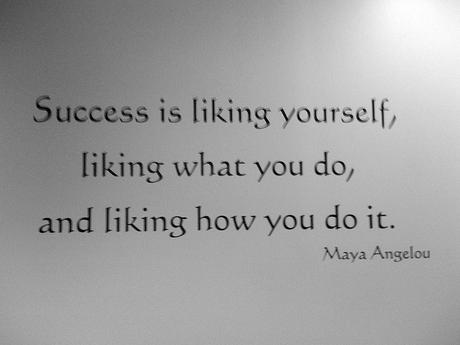
While it's never too late to start, it can be too late to start smart.
As a college student, you already know it's important to work hard, stay the course, and have a good time.
Yet, as a young professional and a college-to-career adviser, I can assure you it's also important to set the foundation for your post-college life and career. What's more, while it's never too late to start, it can be too late to start smart - even if graduation and "real life" feel like a long ways off.
Over the past few years, I've spent much of my time curating lessons from the most celebrated authors and thinkers on business, productivity, creativity, human behavior, and more. So, to help kick-start your process, here are 10 keys to a successful life and career.
10. Pique your peak experiences.
What's your fondest memory? Whether it's a significant event or a sheer moment in time, I'm sure you cherish it.
Throughout your life, many of your experiences will be etched in your memory, so work to be truly present as they happen. Moreover, by actively anticipating them, you're almost certain to enjoy them twice as much. James Clear, the author of the New York Times best seller "Atomic Habits," teaches that the anticipation of an event can be as important as the event itself, and likewise, that our brains relish anticipation. "The greater the anticipation, the greater the dopamine spike," he says.
9. Step outside your comfort zone.
It's human nature to gravitate toward what's easy and comfortable. In fact, by some estimates, 50 percent of what we do requires little to no active thinking, as if we're moving through life on autopilot. The problem, however, is that discomfort, not to mention the occasional failure, is essential to growing and evolving as a person. So why not choose to step outside your comfort zone? By setting stretch goals and embracing being uncomfortable, you'll accelerate your growth.
Now, if you're wondering just how far outside your comfort zone you should step, author-expert James Clear (cited above) recommends around 104 percent - a stretch that is still within reach.

8. Get good at negotiation.
As you move from graduation to retirement, one thing's for sure: You're going to change jobs.
According to a national longitudinal survey by the U.S. Bureau of Labor Statistics, individuals born in the latter years of the baby boom (1957-1964) held an average of 12.4 jobs from ages
18 to 54. Just think, then, what that average might be for Generation Z, who according to
a survey from LinkedIn, are three times more likely than baby boomers to change jobs.
One negotiating staple is the all-important zone of possible agreement, or ZOPA, which is the range in a negotiation in which two parties can find common ground. For example, let's say that your salary requirement for a new position is $70,000 to $80,000. If a prospective employer is prepared to offer between $65,000 and $75,000, then you've got a ZOPA. But if they aren't willing to go above $65,000, then you don't.
Also, while you can align your salary figure with ZOPA-maximized employers, I'd recommend anchoring on your figure, not theirs. Additionally, avoid shooting yourself in the foot by researching pay on sites like Glassdoor, Indeed, CompGauge, Payscale, and AngelList, among others.
Yet salary isn't everything in a job negotiation. And that's where another negotiating technique, a process known as logrolling, comes in. Logrolling is the act of trading across issues in a negotiation. It's here that you can "logroll" other priorities, such as the opportunity to work remotely, realize performance incentives, or earn equity in the business.
7. Stay in motion by following through and following up with others.
Daniel Pink, the author of such mega best-selling books as "Drive," "When," and "To Sell Is Human," said: "An object in motion will stay in motion, and an object at rest will stay at rest, unless acted on by an outside force."
Sure, lots of people stay at rest. But that's no excuse to be one of them. One of the simplest ways to stay in motion is to regularly seek advice from successful people and then see that advice through rather than let it die on the table. This also includes circling back with those people to both thank them and share your progress and results. This way, you can showcase your differentiation while also making them feel good to have helped you progress in your career.
6. Open a Roth IRA.
What's the greatest investment ever?
Some people might argue that it's cryptocurrency, while others may be all in on gold or collectibles like fine art. Still, for my money, nothing performs better and more consistently than the stock market, especially mutual funds that mirror the S&P 500.
For example, if your family invested $1000 in the S&P 500 at the beginning of 1980, they'd have close to $12,000 at the beginning of 2021. This is a return on investment of 12.10 percentper year, or when adjusted for inflation, 8.92 percent per year. (To learn more, look here.)
Now, before your eyes glass over, imagine that today you invest $10,000 in the S&P 500. Forty years later, with 8.92 percent compounded annually, you'd be looking at just over $353,000, which in today's terms, is about the typical home value in the U.S. and a brand-new BMW 4 Series. Not bad for $10K.
I specifically call out a Roth IRA (which you can open as soon as you have taxable income) because not only do your earnings grow tax-free, your qualified withdrawals are also tax-free if taken after age 59 and a half - meaning, the tax savings are hard to beat.

5. Build a network early.
Too many college students devote all their time on academic achievement and an extracurricular activity or two, only to graduate and just ask people, "Can you help me get a job?"
To avoid this less-than-appealing state of neediness, commit to building a network of connections while you're still in school, when you don't need it - yet. This includes mentors, advocates, coaches, professors, internship sponsors, and others. Start by asking for their real-world advice, recommendations, and insights, along with proactively offering to reciprocate, perhaps by assisting them with social media brand-building, watching or tutoring their kids, or something as simple as walking their dog.
4. Know your unique value proposition.
You might spend tens of thousands of dollars on college to get in the door, but fact is, what you do once you get in the door is entirely up to you.
This starts with knowing your unique value proposition, or UVP. Now, you might be thinking that you don't have a UVP. After all, with virtually no experience, you have little to nothing to offer. But you're not competing with Elon Musk here; you're competing with your peers. So craft a compelling story that showcases your very own category of one. Also, know that while we are all unique, unless you can explicitly tell me what makes you unique, I'll move on to someone who can.
For most of us, it's through combining our unique skills that make us unmatched. One oft-cited example of this is the rise of Scott Adams, more commonly known as the creator of Dilbert, the main and much-loved protagonist of the comic strip Dilbert. Pre-Dilbert, Adams was neither the greatest writer nor the greatest satirist, yet he combined his unique talents to create one of the most iconic and celebrated comic strips of all time.
So what skills can you combine to create a compelling story and UVP? Or more simply, what's your Dilbert?

3. Take an active interest in others.
Self-improvement pioneer Dale Carnegie, the author of the classic book "How to Win Friends and Influence People," said: "You can make more friends in two months by becoming interested in other people than you can in two years trying to get other people interested in you."
This rings as true today as ever, even as many people spend more time counting their social-media likes and followers than on cultivating real relationships with others.
The bottom line is that people will naturally be drawn to you if you take an active and sincere interest in them, including truly listening to what they have to share. Organizational psychologist Adam Grant, a perennially top-rated professor at Wharton and a best-selling author, calls this "inverse charisma."
2. Focus your time and energy on what matters most.
Renowned author and high-performance coach Brendon Burchard writes and speaks on mastering what he calls your PQO, or prolific quality output - the simple idea of focusing on the fundamental things that can make you better than others in your field. For instance, Burchard says that when you look closer at how the world's greatest athletes - e.g., Michael Jordan, Tiger Woods, and Tom Brady - became who they are, the common denominator is that they focused almost solely on the fundamentals that improved their overall physical and mental skills.
In his book "The Science of Intelligent Achievement," author and scientist Isaiah Hankel, an expert on mental focus and career development, says that we only get about 90-120 minutes of peak mental energy each day, along with five hours or less of "near" peak mental energy. The takeaway? How you choose to spend your day can make the difference between someone deeming your performance as "not bad" versus "the best I've ever seen."
To figure out what matters most to you, try following the Japanese concept Ikigai, which combines the terms iki, meaning "alive" or "life," and gai, meaning "benefit" or "worth."
Meaning and Purpose
When combined, these terms mean that which gives your life worth, meaning, or purpose.
Reflecting on your own Ikigai may take some time and dedication, but it shouldn't be hard or complicated; in fact, it can be pretty simple and even spark joy. First, find your positive energy source - that thing that consistently drives inspired action. This could be as simple as 30 minutes of exercise, or if you're like many of my students, spending quality time outdoors, using positive visualization techniques, or practicing uplifting self-affirmations.
Whatever fuels your fire, stoke the coals and stay close. The last thing you want to do is to feel inspired, only to end up binge-watching a Netflix show - tossing aside your peak mental energy. Isaiah Hankel would not approve.
1. Allocate your money wisely.
How you allocate your hard-earned money is important in both the here and now and in future. I suggest using what I call the 14-28-56 rule: Allocate 14 percent to your wants, 28 percent to your savings and investments, and 56 percent to your needs - a model that, as you can see, intentionally doubles. Among the many beauties here is that you automatically have 2 percent remaining, which builds in some flexibility when life throws you a curveball.
Chances are, all those percentages sound like gobbledygook now. But I promise that if you stick as close as possible to this plan, you'll be all the better and more secure for it.
So, my college-going friends, I hope these 10 keys will help you set the foundation for a successful life and career. And remember, while it's never too late to start, it can be too late to start smart.
This guest post was authored by Alex Dripchak
Alex is a sales and career-readiness adviser based in New York City. His experience includes being a relationship manager at Mercer, a global HR consulting leader, and a sales manager and outside producer in HR software at the tech giant Oracle. He is the author of "100 Skills of the Successful Sales Professional" (Business Expert Press, 2021) and the co-founder of Commence, a breakthrough college-to-career skills development program.

Ms. Career Girl was started in 2008 to help ambitious young professional women figure out who they are, what they want and how to get it.

